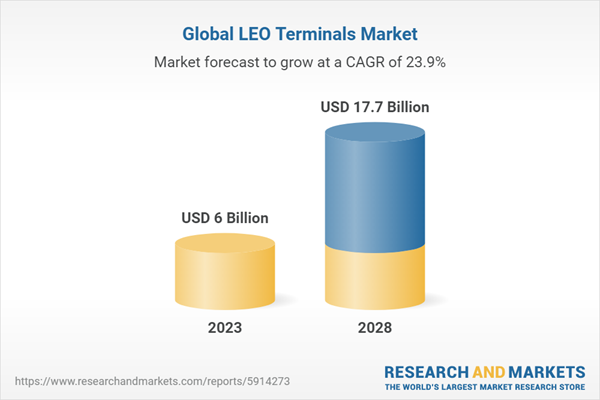The LEO terminals market is estimated to grow from USD 17.7 billion by 2028, from USD 6.0 billion in 2023, at a CAGR of 23.9% from 2023 to 2028. North America is estimated to account for the largest share of the LEO terminals market in 2023.
LEO terminals are rapidly displacing conventional applications in the commercial sector, such as communication, earth observation & remote sensing, and scientific purpose. The increased adoption of LEO terminals in various civil and commercial applications is driven by their exceptional endurance and cost-effectiveness. Furthermore, the integration of emerging technologies like artificial intelligence, IoT, and cloud computing into LEO terminals is anticipated to further boost their demand across various sectors.
Based on Platform, includes segments such as fixed, portable and mobile . Notably, the mobile segment is forecasted to experience the most substantial growth. Mobile terminals are expected to witness substantial growth, driven by factors such as the expanding availability of LEO satellite networks offering high-speed broadband connectivity, the rising demand for mobile satellite services in remote and underserved regions, and the ongoing development of innovative mobile satellite terminal technologies.
Based on Vertical, the LEO terminals market is segmented into commercial and government & defense. The government & defense segment is expected to witness the highest growth during the forecast period due to the rising demand for secure communications solutions to drive growth.
Based on frequency, the LEO terminals market has been categorized into several segments, including C-band, L- & S-band, X-band, Ka-band, Ku-band, VHF/UHF-band, EHF/SHF-band, Q-band, and multi-band. Ku-band frequencies. Among these frequency areas, the ku-band segment is projected to be the predominant driver of market growth, characterized by the highest Compound Annual Growth Rate (CAGR) during the forecast period. This trend can be attributed to the increasing demand for expeditious for various applications, particularly in broadband internet access and mobile connectivity, which has seen heightened demand.
North America is expected to hold the highest market share in 2023.
The North American LEO terminal market is substantiated by a constellation of factors. Foremost is the escalating demand for high-speed internet connectivity. With North America's status as a highly developed region boasting a sizable and burgeoning population, the need for swift internet connectivity is on the ascent, particularly in rural locales. LEO terminals are recognized as a practical solution, effectively offering cost-effective and dependable internet accessibility to these underserved regions.
North America is projected to maintain the predominant market share in 2023. This notable regional growth can be attributed to the burgeoning trend of online retail via e-commerce platforms and the favorable regulatory framework established by the Federal Aviation Administration (FAA) in the United States. Moreover, the increase in investments from prominent industry stakeholders to bolster emerging parcel service platforms is anticipated to be a significant driver of the regional market's expansion throughout the forecasted period.
The break-up of profile of primary participants in the LEO terminals market:
- By Company Type: Tier 1 – 35%, Tier 2 – 45%, and Tier 3 – 20%
- By Designation: C Level – 35%, Director Level – 25%, and Others – 40%
- By Region: North America – 40%, Europe – 20%, Asia Pacific – 30%, Middle East & Africa – 5%, Latin America – 5%
Winners of LEO terminals market are SpaceX (US), EchoStar Corporation (US), L3Harris Technologies, Inc. (US), Thales (France), Raytheon Technologies (US), and Kymeta Corporation (US). These key players offer connectivity applicable for various sector and have well-equipped and strong distribution networks across North America, Europe, Asia Pacific, Middle East & Africa and Latin America.
Research Coverage:
In terms of Platform, the LEO terminals market is divided into Fixed, Platform and Mobile.
The vertical based segmentation includes commercial and government & defence. The commercial segment of the LEO terminals market is diverse, encompassing telecommunications & cellular backhaul, media & entertainment, business & enterprise, transportation & logistics, scientific research & development, aviation, marine, retail & consumer, and other markets.
The LEO terminals market, with regard to frequency, is categorized into end-to-end and point solutions. The end-to-end solution encompasses all platform services, such as piloting and operations, data analytics, and data processing. In contrast, point solutions are specific to piloting or data processing for applications such as surveying, inspection, and monitoring.
This report segments the LEO terminals market across five key regions: North America, Europe, Asia Pacific, the Middle East & Africa and Latin America, along with their respective key countries. The report's scope includes in-depth information on significant factors, such as drivers, restraints, challenges, and opportunities that influence the growth of the LEO terminals market.
A comprehensive analysis of major industry players has been conducted to provide insights into their business profiles, solutions, and services. This analysis also covers key aspects like agreements, collaborations, new product launches, contracts, expansions, acquisitions, and partnerships associated with the LEO terminals market.
Reasons to buy this report:
This report serves as a valuable resource for market leaders and newcomers in the LEO terminals market, offering data that closely approximates revenue figures for both the overall market and its subsegments. It equips stakeholders with a comprehensive understanding of the competitive landscape, facilitating informed decisions to enhance their market positioning and formulate effective go-to-market strategies for LEO terminals . The report imparts valuable insights into the market dynamics, offering information on crucial factors such as drivers, restraints, challenges, and opportunities, enabling stakeholders to gauge the market's pulse.
The report provides insights on the following:
- Analysis of the key drivers (Increasing demand for cost-effective, high-speed connectivity, Rapid integration of Internet of Things, Expansion of LEO satellite constellations, Government initiatives for development of LEO terminals), restraint (High cost of LEO terminals , Availability of other broadband technologies) opportunities (Widescale applications of LEO terminals, Growing demand for connectivity from developing countries) and challenges (Technical constraints associated with development and launch of LEO satellites, Threat of data interception, unauthorized access, and cyberattacks, Rise in environmental concerns) there are several factors that could contribute to an increase in the LEO terminals market.
- Market Penetration: Comprehensive information on LEO terminals system offered by the top players in the market
- Product Development/Innovation: Detailed insights on upcoming technologies, research & development activities, and new product & service launches in the LEO terminals market
- Market Development: Comprehensive information about lucrative markets – the report analyzes the LEO terminals market across varied regions
- Market Diversification: Exhaustive information about new products & services, untapped geographies, recent developments, and investments in the LEO terminals market
- Competitive Assessment: In-depth assessment of market shares, growth strategies and service offerings of leading players in the LEO terminals market
Table of Contents
Companies Mentioned
- Spacex
- L3Harris Technologies, Inc
- Kymeta Corporation
- Echostar Corporation
- Thales
- Raytheon Technologies
- General Dynamics Corporation
- Honeywell International Inc.
- Aselsan A.S.
- Intellian Technologies, Inc
- St Engineering
- Ball Corporation
- Cobham Satcom
- Gilat Satellite Networks
- Viasat, Inc
- Thinkom Solutions, Inc.
- Norsat International Inc
- APT Satellite Co. Ltd
- Satcube
- Mynaric AG
- Leosat Enterprises
- AVL Technologies, Inc
- Kepler Communications Inc
- Kratos Defense & Security Solutions, Inc.
- Saint-Gobain Composite Solutions
Table Information
| Report Attribute | Details |
|---|---|
| No. of Pages | 249 |
| Published | November 2023 |
| Forecast Period | 2023 - 2028 |
| Estimated Market Value ( USD | $ 6 Billion |
| Forecasted Market Value ( USD | $ 17.7 Billion |
| Compound Annual Growth Rate | 23.9% |
| Regions Covered | Global |
| No. of Companies Mentioned | 25 |









